Class 7 Science Chapter 9 Question Answers - Motion and Time
Q1. Explain the concept of relative motion with one example. How does the observer’s frame of reference affect the perception of motion?
Answer:
Relative motion refers to the motion of an object as observed from the perspective of another object or observer, called the frame of reference. The way an object’s motion appears depends on the observer’s own position or movement.
For example, imagine two friends, A and B, sitting in a car moving at 40 km/h. To a person standing on the road, both A and B are moving at 40 km/h. But to A inside the car, B appears stationary because they are both moving at the same speed relative to the car. If another car passes them at 50 km/h in the same direction, A will see it moving ahead at 10 km/h (50 km/h - 40 km/h). This shows how the same motion looks different depending on the observer’s frame of reference.
The frame of reference affects motion perception because motion is always measured relative to the observer. A stationary observer on the ground sees things differently than someone moving in a vehicle, making relative motion a key concept in understanding how motion is described in everyday life.
Q2. Briefly mention how many types of motion are there. Also, name all of them.
Ans: There are four primary types of motion, and they can be named as follows:
- Translatory Motion: When an object moves along a straight or curved path (e.g., a car moving on a road).
- Rotatory Motion: When an object spins around a fixed axis (e.g., a spinning top).
- Oscillatory Motion: When an object moves back and forth about a fixed point (e.g., a pendulum).
- Periodic Motion: When an object repeats its motion after a fixed interval of time (e.g., Earth orbiting the Sun).
(Additionally, Rolling Motion is a combination of Translatory and Rotatory motion (e.g., a wheel rolling on the ground)).
Q3. With the help of the data given in the following table, show graphically the relationship between the diameter and circumference of a circle.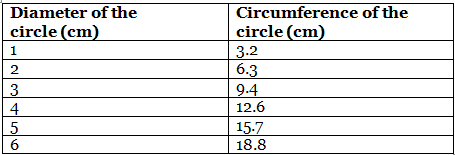
Ans: With the help of a given data in a tabular form, the graph can be obtained by taking diameter of the circle on the x-axis and the circumference on y-axis. On x-axis, 1 cm diameter is shown by 1 cm and on the y-axis, 3 cm of circumference is shown by 1 cm.
Q4. Starting from A, Paheli moves along a rectangular path ABCD as shown in figure. She takes 2 min to travel each side. Plot a distance-time graph and explain whether the motion is uniform or non-uniform.
Ans: Since, the distance covered per unit time for the entire distance covered is not the same, the motion is a non-uniform motion.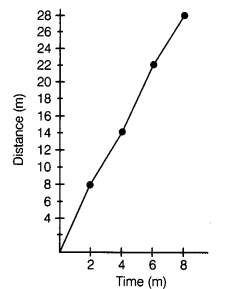
Q5. The following distance-time graph of three objects (D, E and F) are given (see figure given alongside). What can you say about the motion of the objects?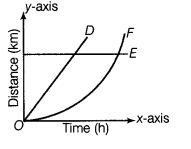
Ans: Since the distance-time graph of object D is a straight line, its motion is uniform. The distance-time graph of object E is parallel to the x-axis (time-axis), so object E is at rest.
As the distance-time graph of object F is a curved line, object F is moving with a non-uniform speed, and its motion is non-uniform.
Q6. The following figure shows the distance-time graph for the motion of two objects D and E. Which one of them is moving slower? Ans: After studying the figure given alongside, D or E is moving slower as the slope of distance-time graph of E is less than that of graph D.
Ans: After studying the figure given alongside, D or E is moving slower as the slope of distance-time graph of E is less than that of graph D.
Q7. The following figure shows the distance-time graph for the motion of two vehicles (C and D). At what time and distance (from the starting point), they will cross each other.
Ans: Firstly, draw perpendicular lines from point E on x-axis and y-axis.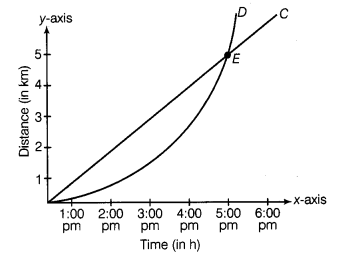 The two vehicles (C and D) will meet (or cross) each other at 5:00 PM and after travelling a distance of 4 km.
The two vehicles (C and D) will meet (or cross) each other at 5:00 PM and after travelling a distance of 4 km.
Q8. Describe the importance of measuring time accurately in the study of motion. Explain how different devices are used to measure time in everyday life and their relevance to understanding motion.
Answer:
Measuring time accurately is crucial in the study of motion because motion is defined as the change in an object’s position over a specific period. Without precise time measurements, it would be impossible to calculate speed (distance divided by time) or analyze how objects move, such as whether they speed up, slow down, or remain constant. Accurate timekeeping helps scientists, engineers, and even athletes study and predict motion effectively.
In everyday life, various devices are used to measure time, each playing a role in understanding motion:
- Clocks and Watches: These are used to measure time in hours, minutes, and seconds. For example, a runner uses a watch to track the time taken to cover a distance, helping calculate their speed.
- Stopwatches: Commonly used in sports or experiments, stopwatches measure short time intervals (e.g., a car’s acceleration over 10 seconds), aiding in detailed motion analysis.
- Sand Timers or Hourglasses: Though less common today, they measure fixed time periods (e.g., 1 minute) and can be used in simple activities like timing a rolling ball’s motion.
These devices are relevant because they provide the time data needed to observe and compare motion patterns. For instance, a stopwatch helps a teacher measure how long a toy car takes to roll down a slope, revealing whether its motion is fast or slow. Accurate time measurement thus forms the foundation for studying and describing motion in both scientific and daily contexts.
Q9. The given data regarding the motion of two different objects C and D is in a tabular form. Check them carefully and state whether the motion of the objects is uniform or non-uniform.
Ans: We can check the motion of the objects C and D by plotting the distance-time graph for the two objects.
Graph the object C on x-axis
Scale 1 cm = 15 min and on y-axis 1 cm = 10 m
Since, the distance-time graph of the object C is a straight line. Therefore, its motion is uniform.
Graph of object D
Scale On x-axis, 1 cm = 15 min, On y-axis 1 cm=5m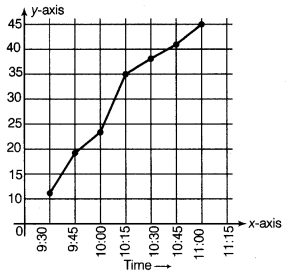 Since, the distance-time graph of the object D is not a straight line, therefore, its motion is non-uniform.
Since, the distance-time graph of the object D is not a straight line, therefore, its motion is non-uniform.
Q10. Differentiate between slow and fast objects.
Ans: An object which takes longer time to cover a certain distance is called slow whereas another object which takes a shorter time to cover the same distance is called fast.
Q11. What is motion? Describe briefly.
Ans: An object that is moving with respect to time and another body is said to be in motion. Motion is measured as the distance covered by an object in a specific interval of time.
Q12. Anshika takes 15 minutes from her house to reach her school on bicycle the distance between her house and the school.
Ans: Time taken = 15 min.
Speed = 2 m/s
Distance = Speed × time
= 15 × 60 × 2 = 1800 m
Thus, the distance between Anshika’s house and her school is 1800 m.
Q13. What are the factors on which time period of a pendulum depends?
Ans: Following are the factors on which time period of a pendulum depends:
- Length of the string of the pendulum.
- Acceleration due to gravity.
Q14. State the difference between uniform motion and non-uniform motion.
Ans: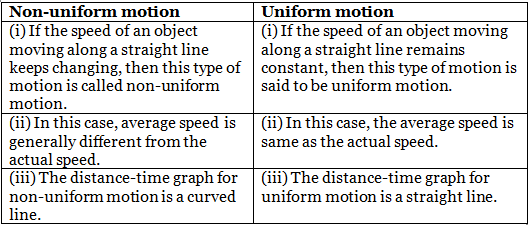
|
111 videos|286 docs|28 tests
|
FAQs on Class 7 Science Chapter 9 Question Answers - Motion and Time
| 1. What is the relationship between motion and time in physics? |  |
| 2. How do we measure time in various scientific experiments? |  |
| 3. What are the different types of motion described in physics? |  |
| 4. How is the concept of uniform motion different from non-uniform motion? |  |
| 5. What is the significance of graphs in understanding motion and time? |  |
















